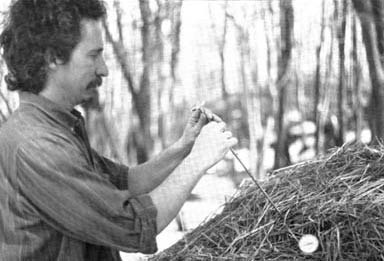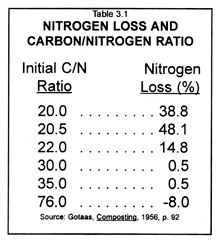
Figure 3.2: The author probing a humanure compost pile in late winter.
This compost had not yet become thermophilically active.
Of the two thermometers, one has a long probe and the other a short one.
PHOTO BY JEANINE JENKINS
| MENU: HOME » Reconstruction » Recovery » Renewal » Survival » Humanure Content |
FOUR NECESSITIES FOR GOOD COMPOST
MOISTURE
Compost must be kept moist. A dry pile will not work. When people who donít understand compost try to picture a humanure compost pile in someoneís backyard, they imagine a giant heap of crap, draining all manner of noxious, smelly liquids out the bottom of the compost bin, and leaching into the groundwater. However, a compost pile is not a pile of garbage or waste. Itís a living, breathing mass, a biological sponge which requires quite a bit of moisture. Itís not likely to create a leaching problem unless subjected to very heavy rains while uncovered.
Why does compost require moisture? For one thing, composted materials shrink incredibly (40-80%),11 mostly because of water loss. Compost can undergo considerable drying when wet materials are composted.12 An initial moisture content of 65% can dwindle down to 20 to 30% in only a week, according to some researchers.13 It is more likely that one will have to add moisture to their compost than have to deal with excess moisture leaching from it.
The amount of moisture a compost pile receives or needs depends on the materials put into the pile and on the location of the pile. In Pennsylvania, there are about 36 inches (about one meter) of rainfall per year, and compost only needs watering during an unusual drought. According to Sir Albert Howard, watering a compost pile in England (where the annual rainfall is 24 inches) is also unnecessary. Nevertheless, the water required for compost-making may be around 200 to 300 gallons for each cubic yard of finished compost.14 This moisture requirement will be met when human urine is used in humanure compost and the top of the pile is open and receiving adequate rainfall. Additional water comes from moist organic materials such as food scraps. If adequate rainfall is not available and the contents of the pile are not moist, watering will be necessary to produce a moisture content equivalent to a squeezed-out sponge. Graywater from household drains or collected rainwater would suffice for this purpose.
OXYGEN
We want to cultivate aerobic bacteria in the compost pile to ensure thermophilic decomposition. This is done by adding bulky materials to the compost pile in order to trap interstitial air spaces. Aerobic bacteria will suffer from a lack of oxygen if drowned in liquid, which is a common problem with commercial and home made composting toilets when improperly managed.
Bacterial decomposition can also take place anaerobically, but this is a slower, cooler process, which can, quite frankly, stink. Anaerobic odors can smell like rotten eggs (caused by hydrogen sulfide), sour milk (caused by butyric acids), vinegar (acetic acids), vomit (valeic acids), and putrification (alcohols and phenolic compounds).15 Obviously, we want to avoid such odors by maintaining an aerobic compost pile.

Figure 3.2: The author probing a humanure compost
pile in late winter.
This compost had not yet become thermophilically
active.
Of the two thermometers, one has a long probe and the other a short
one.
PHOTO BY JEANINE JENKINS
Good, healthy, aerobic compost need not offend oneís sense of smell. However, in order for this to be true, a simple rule must be followed: anything added to the compost that smells bad must be covered with a clean, organic material. This means you must cover the deposits in your compost toilet and on your compost pile. When you defecate or urinate in your toilet, cover it. Use sawdust, use peat, use clean soil, use leaves, but keep it covered. Then there will be no odor. When you deposit smelly manure on your compost pile, cover it. Use weeds, use straw, use hay, whatever you can get your hands on (especially bulky material which will trap oxygen in the compost), but keep it covered. Thatís the simple secret to the odor issue.
TEMPERATURE
Dehydration will cause the compost microorganisms to stop working. So will freezing. Compost piles will not work if frozen, which often occurs during the cold winters of the north. However, donít despair, the microorganisms will wait until the temperature rises and then theyíll thaw out and, once again, work feverishly. You can continue to add to an outdoor compost pile all winter, even when the pile is frozen solid as a rock. The freezing stage helps to destroy some potential pathogens and, after the thaw, the pile works up a steam as if nothing happened.
BALANCED DIET
A good carbon-nitrogen balance (a good blend of materials) is required for a nice, hot compost pile. Since most of the materials commonly added to a compost pile are very high in carbon, this means that a source of nitrogen must be incorporated into the blend of composting ingredients. This isnít as difficult as it may seem. You can carry bundles of weeds to your compost pile, add hay, straw, leaves, and garbage, but youíll still need one thing: nitrogen. Of course the solution is simple ó add manure. Where can you get manure? From an animal. Where can you find an animal? Look in a mirror.
 Rodale states in The Complete Book of Composting
that the average gardener may have difficulty in obtaining manure for the
compost heap, but with ďa little ingenuity and a thorough search,Ē it can
be found. A gardener in the book testifies that when he gets ďall steamed up
to build myself a good compost pile, there has always been one big question that
sits and thumbs its nose at me: Where am I going to find the manure? I am
willing to bet, too, that the lack of manure is one of the reasons why your
compost pile is not the thriving humus factory that it might be.Ē
Rodale states in The Complete Book of Composting
that the average gardener may have difficulty in obtaining manure for the
compost heap, but with ďa little ingenuity and a thorough search,Ē it can
be found. A gardener in the book testifies that when he gets ďall steamed up
to build myself a good compost pile, there has always been one big question that
sits and thumbs its nose at me: Where am I going to find the manure? I am
willing to bet, too, that the lack of manure is one of the reasons why your
compost pile is not the thriving humus factory that it might be.Ē
Hmmm. WHERE can a large animal like a human being find manure? Gee, thatís a
tough one. Letís think real hard about that one. Perhaps with a little
ďingenuity and a thorough searchĒ we can come up with a source. Where IS that
mirror, anyway? Might be a clue there.
Source: The Humanure Handbook. Jenkins
Publishing, PO Box 607, Grove City, PA 16127. To order, phone:
1-800-639-4099.
http://www.jenkinspublishing.com/
| MENU: HOME » Reconstruction » Recovery » Renewal » Survival » Humanure Content |